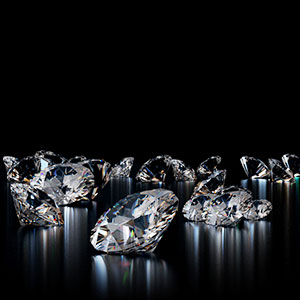
While much discussion about lab-grown diamonds has centered on the question of whether they’re taking market share from naturals, less has been said about lab-growns possibly infiltrating the mined diamond supply chain.
But there’s evidence that they are—from fraudulent inscriptions spotted by labs to the recent case of a jeweler charged with selling synthetics as naturals. And some expect we’ll see more of these incidents, especially if the price differential between natural and lab-grown diamonds continues to grow.
(Under the Federal Trade Commission’s jewelry industry guides, synthetic diamonds must be clearly labeled as lab- or brand-created or -grown; if a diamond is sold without any modifier, it must be a natural gemstone.)
New York City dealer Matthew Schamroth, head of the Diamond Manufacturers & Importers Association’s (DMIA) Diamond Integrity Committee, says that diamond sellers who don’t have proper screening devices and procedures are “flying blind.”
“If you don’t have the policies and protocols and think, ‘I’m good,’ I promise you, you’re not,” he says. “If you are not verifying your goods to make sure that they are natural, you do not know. I never thought I’d say that, but you don’t.”
Schamroth notes that diamond dealers and jewelers are considered subject-matter experts, which means they have a responsibility to verify what they’re selling. And he thinks that DVIs—the new acronym for “diamond verification instruments”—eventually will become as common in diamond dealerships as scales.
“I never look at a stone without weighing it first,” he says. “I don’t even think about it. Putting diamonds on a scale is habitual.”
Jewelers should test not only what comes in off the street, but even what they get from their suppliers, according to industry authorities. “There is no such term as ‘trusted vendor’ anymore,” Stuller senior gemologist Guy Borenstein said last year on the Paul Zimnisky Diamond Analytics podcast. ”Everything must be screened.… Unfortunately, we’ve got to the point that you can’t things for granted.”
DMIA recently installed several screening devices in its New York City office, which are available for member use by appointment. This screening center allows dealers to test the devices to see which ones fit their needs. Schamroth recommends that dealers also check the Natural Diamond Council’s Assure Program page, which shows how the devices stack up as far as features, accuracy, and price.
Many DVIs are expensive, but Schamroth says they are part of the cost of doing business these days. “If you’re spending $1 million a year on natural diamonds, to spend $20,000 to protect that investment, it’s nothing when looked at as a one-time expense that gets amortized out over the years,” he says.
Most of the devices on the market are screeners, not detectors; they determine which diamonds might be synthetic, but in most cases, only a lab can make a final determination. The International Gemological Institute recently instituted a same-day diamond verification service for DMIA members.
It’s possible that some misidentification of lab-created diamonds results from carelessness and not deceit; there’s anecdotal reports of natural diamonds being found in parcels of lab-growns, even though natural diamonds cost more. While the rules are fuzzier when it comes to naturals being sold as lab-growns, most experts believe that anyone who deals in diamonds has the legal and ethical responsibility to clearly and accurately describe what they sell. Which means that if you say you sell someone a natural diamond necklace, it shouldn’t contain synthetics—and vice versa.
The subject of nondisclosure about lab-grown diamonds is discussed on the latest episode of JCK’s podcast, The Jewelry District.
(Photo: Getty Images)
Follow JCK on Instagram: @jckmagazineFollow JCK on Twitter: @jckmagazine
Follow JCK on Facebook: @jckmagazine





